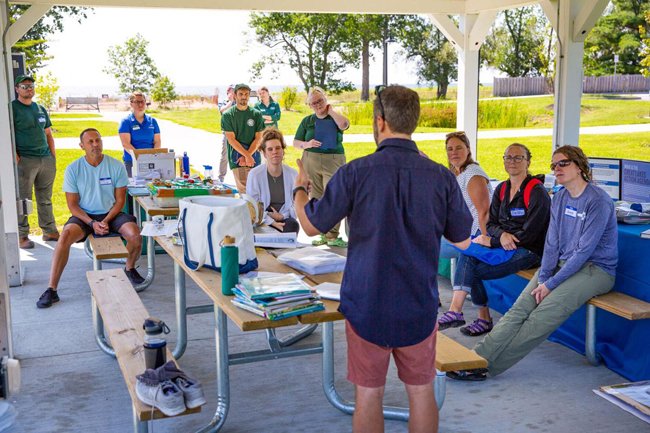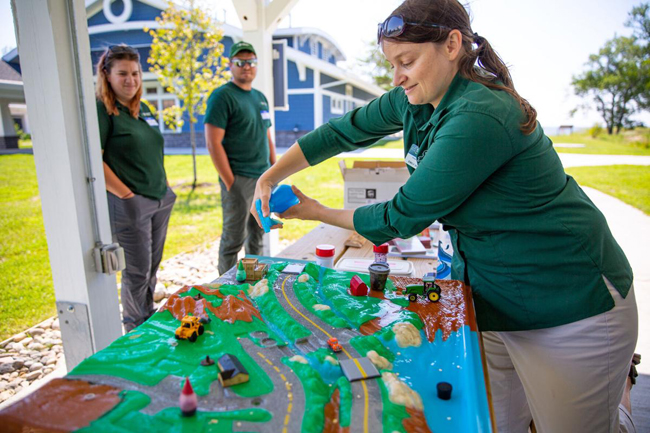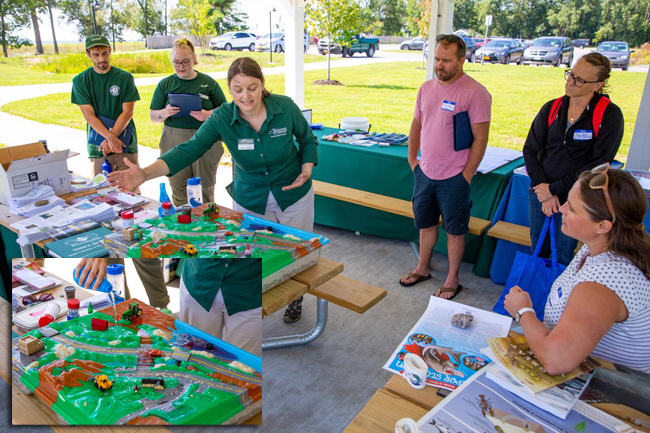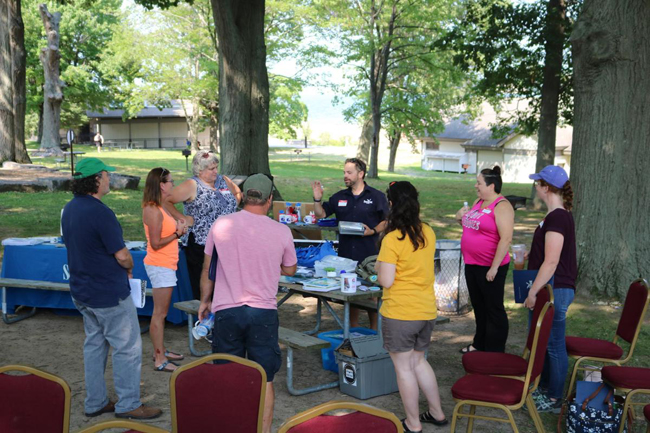
Nate Drag, New York Sea Grant Great Lakes Literacy Specialist, runs through resources at a New York Sea Grant (NYSG)—NYS Department of Environmental Conservation (NYSDEC) Great Lakes education workshop at Southwick Beach State Park in Henderson on July 21st. Credit: Kara Dry/Watertown Daily Times.
Workshop held to inspire environmental learning, stewardship at Southwick Beach
— By Rachel Burt; Published in NNY360
Henderson; Fair Haven, NY, August 10, 2021 - Though the day started out a bit iffy in terms of weather, the skies cleared and the sun shone Wednesday afternoon, just in time for a Great Lakes Education Workshop aimed at educating teachers about various topics and resources available for their classrooms.
Under one of the pavilions at Southwick Beach State Park, representatives from New York Sea Grant, New York State Parks and the state Department of Environmental Conservation gathered to speak to and demonstrate for teachers from schools such as Belleville-Henderson, Carthage and South Jefferson, as well as from places like Central Square and Mexico in Oswego County.
“It’s all about supporting teachers and educators in their efforts to teach kids about the Great Lakes,” said Nate W. Drag, New York Sea Grant Great Lakes literacy specialist and associate director of the Great Lakes Program at the University at Buffalo. “Understanding what resources we have to share with them, what their needs are and connecting them with experts from state parks, DEC, Sea Grants — helping give it to the educators to help their students connect with all of our amazing local ecosystems and water bodies.”
Activities for the afternoon included an introduction and explanation of three new curricula from New York Sea Grant: Enviro-Time Storytime reading lists for K-12, Lake Sturgeon Intermediate Curriculum, Freedom Seekers Underground Railroad and the Great Lakes; an introduction to the Great Lakes Environmental Education Exchange, an experiential program and teaching resources clearinghouse for educators administered by New York Sea Grant and the DEC; a DEC watershed model demonstration; a show and tell of an NYS Parks biocontrol release for management of Emerald Ash Borer; and hands-on dune grass planting.

Emily Sheridan, Eastern Great Lakes Watershed coordinator, demonstrates drainage pollution using a watershed model during a NYSG/NYSDEC Great Lakes education workshop at Southwick Beach State Park in Henderson on July 21st. Credit: Kara Dry/Watertown Daily Times.

Jennie S. Busch, a sixth-grade science teacher at Carthage Middle School, said she has done many different workshops in the past and they were each phenomenal.
“Human activity has had a really significant negative impact on our world and we need to raise generations of students, people, to live more sustainably,” she said. “They need to have a deep understanding of how their choices can impact our ecosystem and our world. It’s important to support teachers and inform us so we can really raise a generation that’s going to take action.”
This was one of four NYSG regional teach-the-teacher workshops this summer to be held at state parks. One was completed earlier at Evangola State Park, and in August, two more workshops will be held at Fair Haven State Park and Hamlin Beach State Park.
With a grant from the Disney Conservation Fund, New York Sea Grant developed a Lake Sturgeon Intermediate Curriculum with activities that meet Next Generation Science and Learning Standards for fourth grade through sixth grade. Collateral materials include digital worksheets, field sampling equipment, a fish tracking tag and the Tale of a Great White Fish book about a fish facing survival challenges similar to those threatening the lake sturgeon. Once abundant in New York state, the lake sturgeon species has been a state-designed threatened species since 1983.
“The curriculum release actually ties really well into some local lake sturgeon conservation milestones that have been achieved recently,” said New York Sea Grant Great Lakes Fisheries and Ecosystem Health Specialist Stacy L. Furgal. “For instance, one of our partners captured the very first female lake sturgeon that had eggs and was ready to spawn in the Genesee River. This is a big milestone because these fish were stocked 18 years ago and are just now reaching an age where they can reproduce. The Genesee River is an area of concern, so it’s even more of an accomplishment that these fish are returning — lake sturgeon are an ecosystem health indicator, so the fact that they’re coming back ready to spawn is showing that environment has gotten better.”
Teachers interested in obtaining a Lake Sturgeon Intermediate Curriculum with supplemental materials to encourage skill development in reading and comprehension, mathematics, ecology, graphing, history and the arts may contact Mr. Drag at 716-645-3610 or nwd4@cornell.edu.
Erin A. Wiley, a science teacher at South Jefferson, has been to a couple past workshops, but knew they added the sturgeon component, so she wanted to go and learn more about the sturgeon. She noted that the workshops are tremendously important because if you cannot get kids involved, nobody is going to preserve.
“Preservation is really what I teach my whole classroom, which was built around teaching from The Lorax: unless somebody cares a whole lot, nothing is going to change,” she said. “I repeat that all year long to my students.”
First timer Peter M. Zimmer, a stewardship specialist with the state parks system, said he wished there was more programming and workshops such as this when he was in school. He hopes that people will realize state parks are more than just a spot to go camping and state park employees are more than just lawn mowers and weed whackers, that they do environmental stewardship work as well, which can mean almost anything from invasive species removals to rare threatened and endangered species habitat restoration projects.
Fred O. Kowanes, of Central Square, attended a presentation a few years ago where trout in the classroom was mentioned, where students raise trout eggs and when they reach fingerling stage, they are released into local streams. He noted that while his students may not like reading and writing, many of them hunt and fish and are very outdoorsy, so they are naturally drawn to this sort of curriculum.
Ms. Furgal noted she is the product of one of her science teachers in high school taking her class out on a field trip where she was first introduced to Sea Grant, where they did a beach grass planting and she talked to a fisheries expert and realized that she could do that as a career. She said fast forward over a decade later and she has replaced the man she met that day, noting that teachers really can help to make a difference in the lives of their students.
“I think it’s really important for educators to be able to have resources that connect them to their local environment,” Ms. Furgal said. “I think historically, in classrooms it is more common you learn things about rain forests, but when it comes to your backyard, you might not have those resources handy, so for us to be able to provide that to classrooms that might not otherwise have access is huge.”
More Info: Great Lakes Education Workshop at Fair Haven State Park

Credit: Auburn Citizen
Central New York teachers attended another recent New York Sea Grant workshop, this one at Fair Haven Beach State Park, with Great Lakes Coastal Literacy Specialist Nate Drag, who demonstrated hands-on activities the teachers can use during the upcoming school year. Drag also introduced teachers to environmental reading lists for children, science literacy activities and other resources, which are available for free through the Great Lakes Ecosystem Education Exchange at www.nyseagrant.org/gleee.
"The Great Lakes represent an unparalleled environmental, cultural, economic and educational resources. New York Sea Grant is pleased to provide new teaching materials that highlight the Great Lakes' unique natural and human history as a way to encourage place-based learning and global environmental stewardship," said Drag, who is also the associate director of the Great Lakes Program at the University at Buffalo.
More Info: New York Sea Grant
New York Sea Grant (NYSG), a cooperative program of Cornell University
and the State University of New York (SUNY), is one of 34 university-based
programs under the National Oceanic and Atmospheric Administration’s
National Sea Grant College Program.
Since 1971, NYSG has represented a statewide network of integrated
research, education and extension services promoting coastal community
economic vitality, environmental sustainability and citizen awareness
and understanding about the State’s marine and Great Lakes resources.
Through NYSG’s efforts, the combined talents of university scientists
and extension specialists help develop and transfer science-based
information to many coastal user groups—businesses and industries,
federal, state and local government decision-makers and agency managers,
educators, the media and the interested public.
The program maintains Great Lakes offices at Cornell University, SUNY
Buffalo, SUNY Oswego and the Wayne County Cooperative Extension office
in Newark. In the State's marine waters, NYSG has offices at Stony Brook
University in Long Island, Brooklyn College and Cornell Cooperative
Extension in NYC and Kingston in the Hudson Valley.
For updates on Sea Grant activities: www.nyseagrant.org has RSS, Facebook, Twitter, Instagram, and YouTube links. NYSG offers a free e-list sign up via www.nyseagrant.org/nycoastlines for its flagship publication, NY Coastlines/Currents, which is published quarterly.